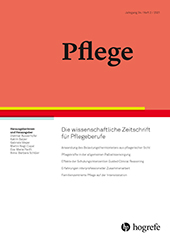In sechs Wochen hat sich die Welt verändert: COVID-19
Familienzentrierte Pflege auf der Intensivstation
Abstract
Zusammenfassung. Hintergrund und Problemstellung: Die Aufnahme von Patientinnen und Patienten auf einer Intensivstation ist für Angehörige während der COVID-19-Pandemie außerordentlich belastend, da sie ihre Familienmitglieder aufgrund einer Besuchsrestriktion nicht besuchen dürfen. Zielsetzungen: Beschreiben des Erlebens von Angehörigen während der COVID-19-Pandemie und Ableiten von Unterstützungshinweisen für Gesundheitsfachpersonen. Methode: Qualitative Analyse dreier schriftlicher Erfahrungsberichte von Angehörigen, deren Familienmitglieder mit COVID-19 oder anderen Krankheiten auf der Intensivstation hospitalisiert waren. Ergebnisse: Angehörige berichten vom plötzlichen, unerwarteten Auftreten der Krankheit. „Es war da, aus dem Nichts, trifft mitten ins Leben, geht nicht einfach weg. Es ist ein unbekanntes Virus, das wir hautnah kennen lernen müssen.“ Das Besuchsverbot machte ohnmächtig. Aber der erste Besuch danach bedeutete eine unbeschreibliche Freude. Zu wissen, wie es um das Familienmitglied steht, und dass Gesundheitsfachpersonen sich professionell und empathisch um den Kranken kümmern, waren Dinge, an denen sich die Angehörigen festhalten konnten. Diskussion: Angehörige waren beruhigt, wenn sie ein hohes Engagement der Fachpersonen und wiederholt nachvollziehbare Auskunft erlebten. Grenzen und Transfer: Besuchsrestriktionen hängen von der nationalen Gesetzgebung ab. Maßnahmen wie Videotelefone können auch außerhalb einer Pandemie helfen, die Beziehung zu Angehörigen aufzubauen.
Abstract. Background and problem definition: The admission of patients to an intensive care unit is extremely stressful for relatives during the COVID-19 pandemic, as they are not allowed to visit their family members due to a visitation restriction. Objectives: To describe the experience of relatives during the COVID-19 pandemic and to derive support information for health professionals. Methods: Qualitative analysis of three written testimonies of relatives whose family members were hospitalized with COVID-19 or other disease at intensive care unit. Results: Relatives report the sudden, unexpected occurrence of the disease. “It was there, out of nowhere, hits the heart of life, doesn’t just go away, does what it wants. It is an unknown virus that we have to get to know very closely.” The ban on visiting was harsh, it made her faint. The first visit was an indescribable joy. Knowing how the family member was and that the health care professionals were taking professional and empathetic care of the sick person were the only things the relatives could hold on to. Discussion: Relatives were reassured when they experienced a high level of commitment on the part of health professionals and received repeated comprehensible information by phone. Limitations and transfer: Restrictions on visits depend on national legislation. Measures such as video calls can also be useful outside of a pandemic to build relationships with relatives.
Literatur
(2020). Communication strategies to mitigate fear and suffering among COVID-19 patients isolated in the ICU and their families. Heart Lung, 49(4), 344 – 345.
(2020). A 5-point strategy for improved connection with relatives of critically ill patients with COVID-19. Lancet Respiratory Medicine, 8(6), e52.
(2019). The impact of intensive care unit diaries on patients’ and relatives’ outcomes: a systematic review and meta-analysis. Critical Care, 23(1), 411.
. (2020). Love in the time of corona. Annals of Internal Medicine, 172(9), 628.
(2017). Guidelines for Family-Centered Care in the Neonatal, Pediatric, and Adult ICU. Critical Care Medicine, 45(1), 103 – 128.
(2015). Emotional disorders in pairs of patients and their family members during and after ICU stay. PLOS ONE, 10(1), e0115332.
(2019). Patients’ perceptions of an intensive care unit diary written by relatives: A hermeneutic phenomenological study. Intensive and Critical Care Nursing, 55, 102751.
(2018). Patient and family engagement in the ICU: Report from the task force of the World Federation of Societies of Intensive and Critical Care Medicine. Journal of Critical Care, 48, 251 – 256.
(2018). Preventing Posttraumatic Stress in ICU Survivors; A Single-Center Pilot Randomized Controlled Trial of ICU Diaries and Psychoeducation. Critical Care Medicine, 46(12), 1914 – 1922.
(2016). The effectiveness of interventions to meet family needs of critically ill patients in an adult intensive care unit: a systematic review update. JBI Database of Systematic Reviews and Implementation Reports, 14(3), 181 – 234.
(2019). Family-centred care in the intensive care unit: More than just flexible visiting hours. Intensive and Critical Care Nursing, 50, 1.
(2019). The Effect of ICU Diaries on Psychological Outcomes and Quality of Life of Survivors of Critical Illness and Their Relatives: A Systematic Review and Meta-Analysis. Critical Care Medicine, 47(2), 273 – 279.
(2017). A family information brochure and dedicated website to improve the ICU experience for patients’ relatives: an Italian multicenter before-and-after study. Intensive Care Medicine, 43(1), 69 – 79.
(2020). Interventions in Post-Intensive Care Syndrome-Family: A Systematic Literature Review. Critical Care Medicine, 48(9), e835 – e840.



